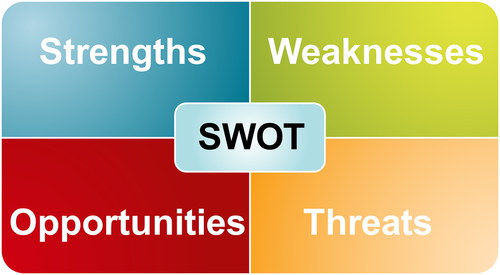The SWOT Analysis, developed in the 1960s at Stanford University, is a strategic planning method used to evaluate the Strengths, Weaknesses, Opportunities, and Threats involved in a project or a business venture. It considers internal and external factors that are favorable and unfavorable to achieve the business objective.

Early Greek philosophers summed up the desired results of this process in two words, “Know Thyself.”
Consider the following questions as you identify the Strengths, Weaknesses, Opportunities, and Threats of your organization:
What are your Strengths?
What are your business or selling advantages?
What do you do better than anyone else?
What is making you the most money?
What unique or low-cost resources do you draw upon?
What do others see as your strengths?
Consider your strengths from an internal perspective, and from the point of view of your customers. Remember, your strengths are only those areas in which you truly out-perform others. If your competitor’s delivery time is just as fast as your delivery time, then fast-delivery is not a strength, but a market requirement just to be competitive.
What are your Weaknesses?
What are you avoiding?
Where do you lack resources?
What obstacles are in your path?
Where are you losing money?
What needs improvement?
What do customers or employees complain about?
Do other people see weaknesses you don’t see? What are your competitors doing better than your company? If your customer service needs an overhaul, if your delivery time is too long, if you have a lot of returns or customer complaints, face the brutal facts now and go fix the business systems or processes that are hurting your performance.
What are your best Opportunities?
What new trends or emerging markets have possibilities?
What product or service niches are your competitors missing?
What strengths could you turn into opportunities?
What are some new needs or desires of your customers?
How could you take advantage of new technologies?
New opportunities can come from changes in technology, markets, government policy, social patterns, population profiles, and lifestyle. Exploiting your strengths or overcoming weaknesses can also provide you with new opportunities. Look for ways you can become the best solution for your ideal customer. Remember, your target market is the only market you care about.
What are the Threats to your organization?
What barriers are in your way?
What internal or external conditions threaten your organization?
Are competitors getting stronger or more aggressive?
Do you have serious debt or cash-flow problems?
Do you have weak business systems or processes?
Is the economic climate hurting your sales and growth?
Could changing technologies or government regulations threaten you?
You must identify your threats in order to prepare for their possibility or to avoid them altogether. Remember that every business goes through up-and-down cycles. When you are up, market pressures are at work to level the playing field by bringing you down. Never become complacent. Never stop improving!
In the Zone, I have provided worksheets to stimulate your thinking and to perform a SWOT Analysis of your company. You may want to analyze your competition as well. Ideally, you will match your strengths against market opportunities that result from your competitors’ weaknesses or voids.
A SWOT Analysis will illuminate your business strategies that have the most potential. Take an hour or so to do this important exercise.







